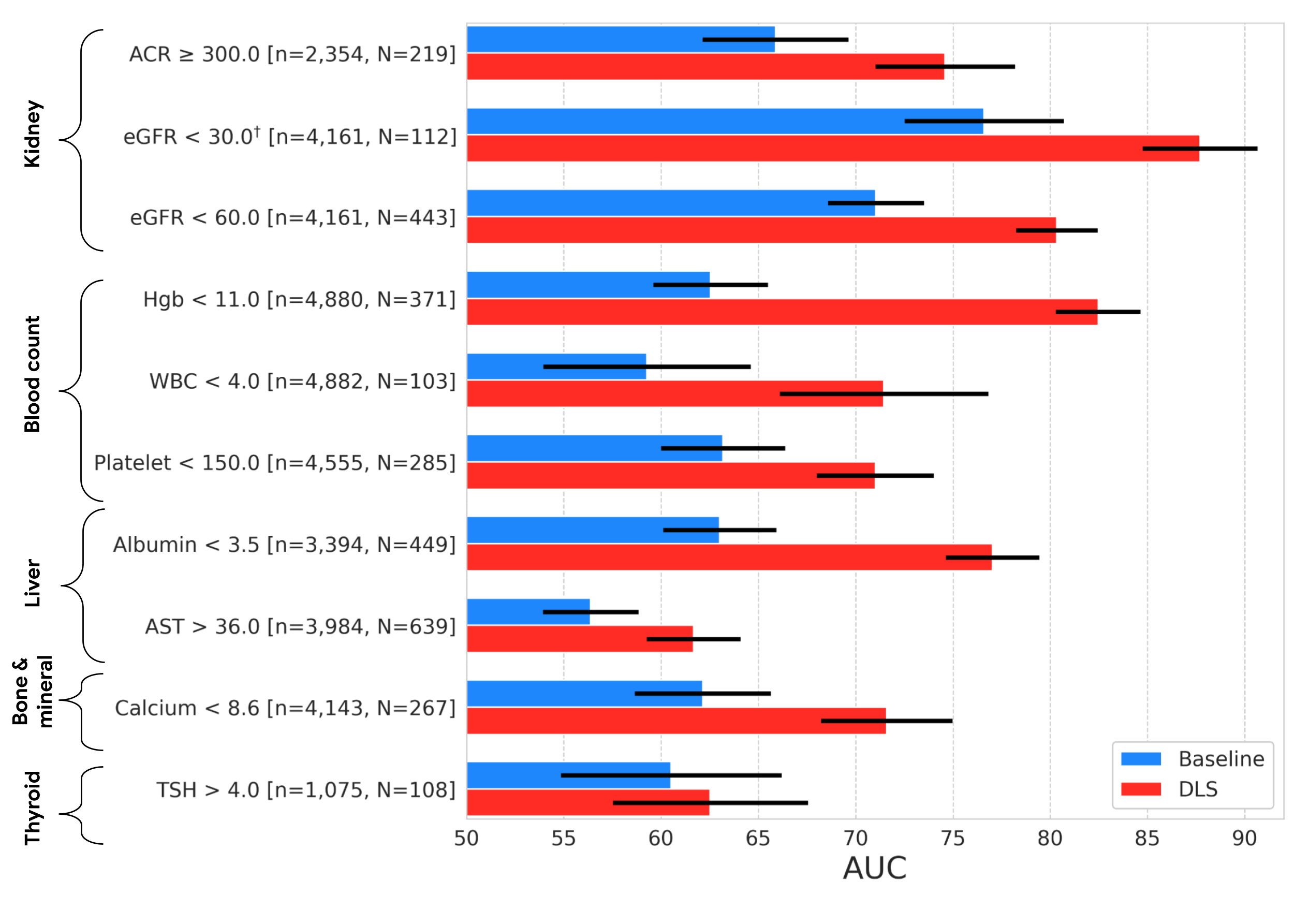
Final 12 months we offered outcomes demonstrating {that a} deep studying system (DLS) may be educated to investigate exterior eye images and predict an individual’s diabetic retinal illness standing and elevated glycated hemoglobin (or HbA1c, a biomarker that signifies the three-month common degree of blood glucose). It was beforehand unknown that exterior eye images contained indicators for these circumstances. This thrilling discovering recommended the potential to cut back the necessity for specialised tools since such images may be captured utilizing smartphones and different client gadgets. Inspired by these findings, we got down to uncover what different biomarkers may be discovered on this imaging modality.
In “A deep studying mannequin for novel systemic biomarkers in images of the exterior eye: a retrospective examine”, printed in Lancet Digital Well being, we present that quite a lot of systemic biomarkers spanning a number of organ techniques (e.g., kidney, blood, liver) may be predicted from exterior eye images with an accuracy surpassing that of a baseline logistic regression mannequin that makes use of solely clinicodemographic variables, resembling age and years with diabetes. The comparability with a clinicodemographic baseline is beneficial as a result of danger for some illnesses is also assessed utilizing a easy questionnaire, and we search to know if the mannequin deciphering photos is doing higher. This work is within the early phases, nevertheless it has the potential to extend entry to illness detection and monitoring by means of new non-invasive care pathways.
 |
| A mannequin producing predictions for an exterior eye picture. |
Mannequin improvement and analysis
To develop our mannequin, we labored with companions at EyePACS and the Los Angeles County Division of Well being Companies to create a retrospective de-identified dataset of exterior eye images and measurements within the type of laboratory assessments and important indicators (e.g., blood stress). We filtered all the way down to 31 lab assessments and vitals that have been extra generally obtainable on this dataset after which educated a multi-task DLS with a classification “head” for every lab and important to foretell abnormalities in these measurements.
Importantly, evaluating the efficiency of many abnormalities in parallel may be problematic due to the next likelihood of discovering a spurious and faulty consequence (i.e., because of the a number of comparisons drawback). To mitigate this, we first evaluated the mannequin on a portion of our improvement dataset. Then, we narrowed the record all the way down to the 9 most promising prediction duties and evaluated the mannequin on our take a look at datasets whereas correcting for a number of comparisons. Particularly, these 9 duties, their related anatomy, and their significance for related illnesses are listed within the desk under.
| Prediction activity | Organ system | Significance for related illnesses | ||||||
| Albumin < 3.5 g/dL | Liver/Kidney | Indication of hypoalbuminemia, which may be resulting from decreased manufacturing of albumin from liver illness or elevated lack of albumin from kidney illness. | ||||||
| AST > 36.0 U/L | Liver |
Indication of liver illness (i.e., harm to the liver or biliary obstruction), generally attributable to viral infections, alcohol use, and weight problems. |
||||||
| Calcium < 8.6 mg/dL | Bone / Mineral | Indication of hypocalcemia, which is mostly attributable to vitamin D deficiency or parathyroid problems. | ||||||
| eGFR < 60.0 mL/min/1.73 m2 | Kidney |
Indication of continual kidney illness, mostly resulting from diabetes and hypertension. |
||||||
| Hgb < 11.0 g/dL | Blood rely | Indication of anemia which can be resulting from blood loss, continual medical circumstances, or poor food plan. | ||||||
| Platelet < 150.0 103/µL | Blood rely |
Indication of thrombocytopenia, which may be resulting from decreased manufacturing of platelets from bone marrow problems, resembling leukemia or lymphoma, or elevated destruction of platelets resulting from autoimmune illness or treatment uncomfortable side effects. |
||||||
| TSH > 4.0 mU/L | Thyroid | Indication of hypothyroidism, which impacts metabolism and may be attributable to many various circumstances. | ||||||
| Urine albumin/creatinine ratio (ACR) ≥ 300.0 mg/g | Kidney |
Indication of continual kidney illness, mostly resulting from diabetes and hypertension. |
||||||
| WBC < 4.0 103/µL | Blood rely | Indication of leukopenia which might have an effect on the physique’s capacity to combat an infection. |
Key outcomes
As in our earlier work, we in contrast our exterior eye mannequin to a baseline mannequin (a logistic regression mannequin taking clinicodemographic variables as enter) by computing the space below the receiver operator curve (AUC). The AUC ranges from 0 to 100%, with 50% indicating random efficiency and better values indicating higher efficiency. For all however one of many 9 prediction duties, our mannequin statistically outperformed the baseline mannequin. When it comes to absolute efficiency, the mannequin’s AUCs ranged from 62% to 88%. Whereas these ranges of accuracy are possible inadequate for diagnostic purposes, it’s in keeping with different preliminary screening instruments, like mammography and pre-screening for diabetes, used to assist establish people who could profit from extra testing. And as a non-invasive accessible modality, taking pictures of the exterior eye could provide the potential to assist display screen and triage sufferers for confirmatory blood assessments or different medical follow-up.
 |
| Outcomes on the EyePACS take a look at set, exhibiting AUC efficiency of our DLS in comparison with a baseline mannequin. The variable “n” refers back to the whole variety of datapoints, and “N” refers back to the variety of positives. Error bars present 95% confidence intervals computed utilizing the DeLong technique. †Signifies that the goal was pre-specified as secondary evaluation; all others have been pre-specified as main evaluation. |
The exterior eye images utilized in each this and the prior examine have been collected utilizing desk high cameras that embrace a head relaxation for affected person stabilization and produce prime quality photos with good lighting. Since picture high quality could also be worse in different settings, we needed to discover to what extent the DLS mannequin is strong to high quality modifications, beginning with picture decision. Particularly, we scaled the pictures within the dataset all the way down to a spread of sizes, and measured efficiency of the DLS when retrained to deal with the downsampled photos.
Beneath we present a number of the outcomes of this experiment (see the paper for extra full outcomes). These outcomes show that the DLS is pretty strong and, typically, outperforms the baseline mannequin even when the pictures are scaled all the way down to 150×150 pixels. This pixel rely is below 0.1 megapixels, a lot smaller than the standard smartphone digital camera.
 |
| Impact of enter picture decision. Prime: Pattern photos scaled to totally different sizes for this experiment. Backside: Comparability of the efficiency of the DLS (purple) educated and evaluated on totally different picture sizes and the baseline mannequin (blue). Shaded areas present 95% confidence intervals computed utilizing the DeLong technique. |
Conclusion and future instructions
Our earlier analysis demonstrated the promise of the exterior eye modality. On this work, we carried out a extra exhaustive search to establish the doable systemic biomarkers that may be predicted from these images. Although these outcomes are promising, many steps stay to find out whether or not know-how like this might help sufferers in the actual world. Particularly, as we point out above, the imagery in our research have been collected utilizing giant tabletop cameras in a setting that managed components resembling lighting and head positioning. Moreover, the datasets used on this work consist primarily of sufferers with diabetes and didn’t have adequate illustration of quite a lot of necessary subgroups – extra centered information assortment for DLS refinement and analysis on a extra normal inhabitants and throughout subgroups will probably be wanted earlier than contemplating medical use.
We’re excited to discover how these fashions generalize to smartphone imagery given the potential attain and scale that this allows for the know-how. To this finish, we’re persevering with to work with our co-authors at accomplice establishments like Chang Gung Memorial Hospital in Taiwan, Aravind Eye Hospital in India, and EyePACS in the USA to gather datasets of images captured on smartphones. Our early outcomes are promising and we look ahead to sharing extra sooner or later.
Acknowledgements
This work concerned the efforts of a multidisciplinary group of software program engineers, researchers, clinicians and cross useful contributors. Key contributors to this mission embrace: Boris Babenko, Ilana Traynis, Christina Chen, Preeti Singh, Akib Uddin, Jorge Cuadros, Lauren P. Daskivich, April Y. Maa, Ramasamy Kim, Eugene Yu-Chuan Kang, Yossi Matias, Greg S. Corrado, Lily Peng, Dale R. Webster, Christopher Semturs, Jonathan Krause, Avinash V Varadarajan, Naama Hammel and Yun Liu. We additionally thank Dave Steiner, Yuan Liu, and Michael Howell for his or her suggestions on the manuscript; Amit Talreja for reviewing code for the paper; Elvia Figueroa and the Los Angeles County Division of Well being Companies Teleretinal Diabetic Retinopathy Screening program employees for information assortment and program assist; Andrea Limon and Nikhil Kookkiri for EyePACS information assortment and assist; Dr. Charles Demosthenes for extracting the info and Peter Kuzmak for getting photos for the VA information. Final however not least, a particular due to Tom Small for the animation used on this weblog publish.

